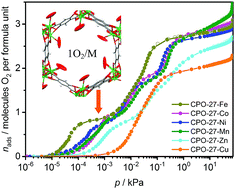当前位置:
X-MOL 学术
›
Phys. Chem. Chem. Phys.
›
论文详情
Our official English website, www.x-mol.net, welcomes your feedback! (Note: you will need to create a separate account there.)
On the elusive nature of oxygen binding at coordinatively unsaturated 3d transition metal centers in metal–organic frameworks
Physical Chemistry Chemical Physics ( IF 3.3 ) Pub Date : 2017-09-18 00:00:00 , DOI: 10.1039/c7cp05119k Mali H. Rosnes 1, 2, 3, 4 , Denis Sheptyakov 5, 6, 7, 8 , Alexandra Franz 9, 10, 11 , Matthias Frontzek 12, 13, 14, 15 , Pascal D. C. Dietzel 1, 2, 3, 4 , Peter A. Georgiev 1, 16, 17, 18, 19
Physical Chemistry Chemical Physics ( IF 3.3 ) Pub Date : 2017-09-18 00:00:00 , DOI: 10.1039/c7cp05119k Mali H. Rosnes 1, 2, 3, 4 , Denis Sheptyakov 5, 6, 7, 8 , Alexandra Franz 9, 10, 11 , Matthias Frontzek 12, 13, 14, 15 , Pascal D. C. Dietzel 1, 2, 3, 4 , Peter A. Georgiev 1, 16, 17, 18, 19
Affiliation

|
Using gas sorption measurements at ambient temperatures and in situ neutron powder diffraction methods, we have studied the interaction strengths and coordination geometries of O2 and N2 near the non-occupied coordination site (open metal site) in the isostructural MOF structures of the CPO-27-M/M-MOF-74 series (with M = Co, Ni, Mn and Cu). Our experimental observations are compared to periodic quantum chemical model calculations. Contrary to recent computational studies, our results, both experimental and theoretical, unequivocally suggest rather weak interactions between the M(II) coordinatively unsaturated centers and the adsorbate molecules, being mainly dispersive and electrostatic in nature. As a consequence, they exclude significant orbital charge transfer effects that could lead to superoxide/peroxide formation. Calculated binding energies appear in good agreement with the measured isosteric heats of adsorption in the range of 10–20 kJ mol−1. These, relatively weak host–guest interactions, lead to a tilted end-on geometry in all of the investigated M(II)–guest molecule adducts.
中文翻译:

关于金属-有机骨架中配位不饱和3d过渡金属中心氧键的难以捉摸的性质
使用环境温度下的气体吸附测量和原位中子粉末衍射方法,我们研究了CPO同构MOF结构中非占据配位点(金属开孔)附近O 2和N 2的相互作用强度和配位几何-27-M / M-MOF-74系列(M = Co,Ni,Mn和Cu)。我们的实验观察结果与周期性量子化学模型计算进行了比较。与最近的计算研究相反,我们的实验结果和理论结果均明确表明M(II)配位不饱和中心和被吸附分子,本质上主要是分散和静电的。结果,它们排除了可能导致超氧化物/过氧化物形成的显着的轨道电荷转移效应。计算出的结合能与在10–20 kJ mol -1范围内测得的等规吸附热表现出很好的一致性。这些相对弱的宿主-客体相互作用导致所有研究的M(II)-客体分子加合物的末端几何形状倾斜。
更新日期:2017-09-22
中文翻译:

关于金属-有机骨架中配位不饱和3d过渡金属中心氧键的难以捉摸的性质
使用环境温度下的气体吸附测量和原位中子粉末衍射方法,我们研究了CPO同构MOF结构中非占据配位点(金属开孔)附近O 2和N 2的相互作用强度和配位几何-27-M / M-MOF-74系列(M = Co,Ni,Mn和Cu)。我们的实验观察结果与周期性量子化学模型计算进行了比较。与最近的计算研究相反,我们的实验结果和理论结果均明确表明M(II)配位不饱和中心和被吸附分子,本质上主要是分散和静电的。结果,它们排除了可能导致超氧化物/过氧化物形成的显着的轨道电荷转移效应。计算出的结合能与在10–20 kJ mol -1范围内测得的等规吸附热表现出很好的一致性。这些相对弱的宿主-客体相互作用导致所有研究的M(II)-客体分子加合物的末端几何形状倾斜。


























 京公网安备 11010802027423号
京公网安备 11010802027423号